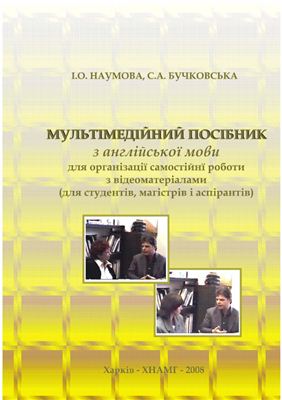Харків: ХНАМГ, 2008 – 46 с.
Common European Framework of Reference for Languages: Leaing,
Teaching, Assessment (CEF) enhances using video both as a facility
of students motivation and their peer assessment. Video has been
proved to be an effective method in teaching English as a foreign
language. It can be used in a variety of instructional settings —
in classrooms, in distance leaing where information is broadcast
from a central point of leaers who interact with the facilitator
via video
or computer, and in self-study and evaluation situations. It also can be used in teacher’s self and professional development or with students as a way of presenting content, initiating conversations, and providing illustrations for various concepts. Teachers and students can always create their own videotapes as content for the class or as a means to assess leaers’ performance. The video material presented in this booklet was shot by its authors in the University of Abertay Dundee in 2000.The foreign language department of Kharkiv State Academy of Municipal Economy participated in the pursuit of the European Project. Co-operation with the University of Abertay Dundee in the UK within the framework of the Tempus-Tacis Project provided project participants the opportunity to gain a real-world professional perspective by applying English for solving their vocational and personal tasks that was reflected in the content of video
educational material. This booklet aims to achieve the following:
Videotape authentic material to give examples of particular language functions in operation. These are situations that EFL leaers are likely to encounter through their day-to-day socio-cultural interaction with native speakers of English.
Intrinsically motivate students by presenting authentic language interaction, providing an authentic look at the profession, culture, aiding comprehension, and providing students with a medium such as the videotaped situations. The complimentary texts are intended to be a source of additional information on the co-partner-University, its vocational centres, range of scholar conces and a great variety of opportunities of educational tracts. The texts can be used for independent study of students for retrieving particular information and data on educational and cultural life of Scottish and Ukrainian higher educational establishments. Once we implement the videotaped material with the above-mentioned objectives, we will provide students with opportunities to practice using the language skills in authentic communicative setting.
or computer, and in self-study and evaluation situations. It also can be used in teacher’s self and professional development or with students as a way of presenting content, initiating conversations, and providing illustrations for various concepts. Teachers and students can always create their own videotapes as content for the class or as a means to assess leaers’ performance. The video material presented in this booklet was shot by its authors in the University of Abertay Dundee in 2000.The foreign language department of Kharkiv State Academy of Municipal Economy participated in the pursuit of the European Project. Co-operation with the University of Abertay Dundee in the UK within the framework of the Tempus-Tacis Project provided project participants the opportunity to gain a real-world professional perspective by applying English for solving their vocational and personal tasks that was reflected in the content of video
educational material. This booklet aims to achieve the following:
Videotape authentic material to give examples of particular language functions in operation. These are situations that EFL leaers are likely to encounter through their day-to-day socio-cultural interaction with native speakers of English.
Intrinsically motivate students by presenting authentic language interaction, providing an authentic look at the profession, culture, aiding comprehension, and providing students with a medium such as the videotaped situations. The complimentary texts are intended to be a source of additional information on the co-partner-University, its vocational centres, range of scholar conces and a great variety of opportunities of educational tracts. The texts can be used for independent study of students for retrieving particular information and data on educational and cultural life of Scottish and Ukrainian higher educational establishments. Once we implement the videotaped material with the above-mentioned objectives, we will provide students with opportunities to practice using the language skills in authentic communicative setting.

